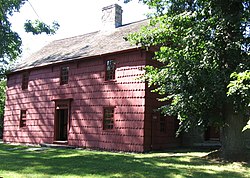
Israel Putnam, popularly known as "Old Put", was an American military officer and landowner who fought with distinction at the Battle of Bunker Hill during the American Revolutionary War (1775–1783). He also served as an officer with Rogers' Rangers during the French and Indian War (1754–1763), when he was captured by Mohawk warriors. He was saved from the ritual burning given to enemies by the intervention of a French officer, Molang, with whom the Mohawk were allied. Putnam's courage and fighting spirit became known far beyond his home of Connecticut's borders through the circulation of folk legends in the American colonies and states celebrating his exploits.

The Battle of Bunker Hill was fought on June 17, 1775 during the Siege of Boston in the first stage of the American Revolutionary War. The battle is named after Bunker Hill in Charlestown, Massachusetts, which was peripherally involved. It was the original objective of both the colonial and British troops, though the majority of combat took place on the adjacent hill which became known as Breed's Hill.
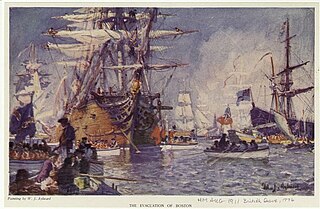
The siege of Boston was the opening phase of the American Revolutionary War. In the siege, American patriot militia led by newly-installed Continental Army commander George Washington prevented the British Army, which was garrisoned in Boston, from moving by land. Both sides faced resource, supply, and personnel challenges during the siege. British resupply and reinforcement was limited to sea access, which was impeded by American vessels. The British ultimately abandoned Boston after eleven months, moving their troops and equipment north, to Nova Scotia.

The Battle of White Plains was a battle in the New York and New Jersey campaign of the American Revolutionary War, fought on October 28, 1776, near White Plains, New York. Following the retreat of George Washington's Continental Army northward from New York City, British General William Howe landed troops in Westchester County, intending to cut off Washington's escape route. Alerted to this move, Washington retreated farther, establishing a position in the village of White Plains but failed to establish firm control over local high ground. Howe's troops drove Washington's troops from a hill near the village; following this loss, Washington ordered the Americans to retreat farther north.
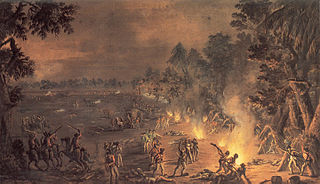
The Battle of Paoli, also known as the Battle of Paoli Tavern or the Paoli Massacre, was a battle in the Philadelphia campaign of the American Revolutionary War fought on September 20, 1777, in the area surrounding present-day Malvern, Pennsylvania. Following the Continental Army's retreat in the Battle of Brandywine and the aborted Battle of the Clouds, George Washington left a force behind under the command of Brigadier General Anthony Wayne to monitor and resist the British as they prepared to attack and occupy the revolutionary capital of Philadelphia.

The Battle of Cowpens was an engagement during the American Revolutionary War fought on January 17, 1781 near the town of Cowpens, South Carolina, between American Patriot forces under Brigadier General Daniel Morgan and British forces, nearly half American Loyalists, under Lieutenant Colonel Banastre Tarleton, as part of the campaign in the Carolinas. The battle was a turning point in the American reconquest of South Carolina from the British.
Samuel Holden Parsons was an American lawyer, jurist, general in the Continental Army during the American Revolutionary War, and a pioneer to the Ohio Country. Parsons was described as "Soldier, scholar, judge, one of the strongest arms on which Washington leaned, who first suggested the Continental Congress, from the story of whose life could almost be written the history of the Northern War" by Senator George F. Hoar of Massachusetts

The Battle of Springfield was fought during the American Revolutionary War on June 23, 1780, in Union County, New Jersey. After the Battle of Connecticut Farms, on June 7, 1780, had foiled Lieutenant General Wilhelm, Baron von Knyphausen's expedition to attack General George Washington's army at Morristown, New Jersey, Knyphausen and Lieutenant General Sir Henry Clinton, British commander-in-chief in North America, decided upon a second attempt. Although the British were initially able to advance, they were ultimately forced to withdraw in the face of newly arriving rebel forces, resulting in a Continental victory. The battle effectively ended British ambitions in New Jersey.

The Forage War was a partisan campaign consisting of numerous small skirmishes that took place in New Jersey during the American Revolutionary War between January and March 1777, following the battles of Trenton and Princeton. After both British and Continental Army troops entered their winter quarters in early January, Continental Army regulars and militia companies from New Jersey and Pennsylvania engaged in numerous scouting and harassing operations against the British and German troops quartered in New Jersey.

Putnam Memorial State Park is a history-oriented public recreation area in the town of Redding, Connecticut. The state park preserves the site that Major General Israel Putnam chose as the winter encampment for his men in the winter of 1778/1779 during the American Revolutionary War. It is Connecticut's oldest state park, created in 1887 at the instigation of Redding town residents. The park was listed on the National Register of Historic Places in 1970.

The history of Greenwich, Connecticut, United States.
The Battle of Ridgefield was a series of American Revolutionary War skirmishes in Danbury, Connecticut and Ridgefield, Connecticut.

The Battle of Forts Clinton and Montgomery was an American Revolutionary War battle fought in the Hudson Highlands of the Hudson River valley, not far from West Point, on October 6, 1777. British forces under the command of General Sir Henry Clinton captured Fort Clinton and Fort Montgomery and then dismantled the first iteration of the Hudson River Chains. The purpose of the attack was to create a diversion to draw American troops from the army of General Horatio Gates, whose army was opposing British General John Burgoyne's attempt to gain control of the Hudson.
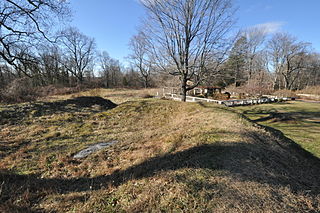
The Fort Stamford Site, site of Fort Stamford, is a public park at 900 Westover Road in the Westover neighborhood of Stamford, Connecticut. It was listed on the National Register of Historic Places in 1975. It is the site of the archaeological remnants of a military earthworks erected during the American Revolutionary War. The fort's location gave a clear view of the Mianus River and Long Island Sound.

The Putnam Hill Historic District encompasses a former town center of Greenwich, Connecticut. Located on United States Route 1 between Milbank Avenue and Old Church Road, the district includes the churches of two historic congregations, a former tavern, and a collection of fine mid-Victorian residential architecture. The district was listed on the National Register of Historic Places in 1979.
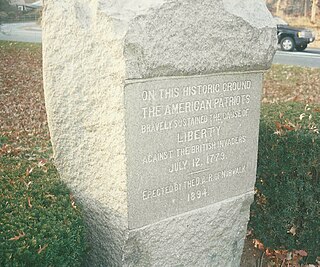
The Battle of Norwalk was a series of skirmishes between the Thirteen Colonies and Great Britain during the American Revolutionary War. The attack was one part of a series of raids on coastal Connecticut towns collectively known as Tryon's raid. The battle was fought in Norwalk, Connecticut on July 11, 1779. 70th (Surrey) Regiment of Foot of Great Britain commanded by Major General William Tryon arrived on July 10, 1779. They marched in a two pronged attack on both sides of the Norwalk River. They followed a path along what is today East and West Avenues burning everything along the way. Only six houses within the business district at Head of River were spared.
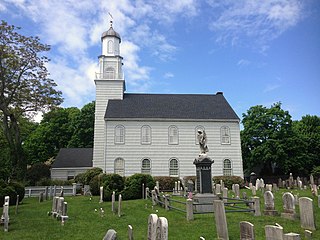
The Battle of Setauket was a failed attack during the American Revolutionary War on a fortified Loyalist outpost in Setauket, Long Island, New York, by a force of Continental Army troops from Connecticut under the command of Brigadier General Samuel Holden Parsons.

The Burning of Fairfield refers to the action of the American Revolutionary War at Fairfield, Connecticut on July 7, 1779 after a British landing force under the command of General William Tryon attacked the town, engaged and dispersed its militia forces, and burned down the vast majority of its buildings. Much of the action took place in areas that are now part of Bridgeport, Southport, and Westport.

General Israel Putnam, also known as Putnam's Escape at Horseneck, is an equestrian statue at the Putnam Memorial State Park in Redding, Connecticut, United States. The statue was designed by sculptor Anna Hyatt Huntington and dedicated in 1969 in honor of Connecticut native Israel Putnam, a military officer who served in the Continental Army during the American Revolutionary War.
